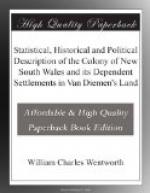This variety of production, and the additional encouragement thus afforded by it, to what is well known to be one of the main sources of national wealth, is sufficient to account for the superior degree of civilization, affluence, and power, which have in general characterized those countries whose rivers take a northern or southern course. Some few nations, indeed, which do not possess such great natural advantages, have supplied the want of them by their own skill and industry, and have in the end triumphed over the efforts of nature to check their progress. Of a people who have thus overstepped these natural barriers opposed to their advancement, and in spite of them attained the summit of wealth and civilization, China perhaps furnishes the most remarkable example. The two principal rivers of that country, the Hoang Ho, or Yellow River, and the Kiang Keou, or Great River, runs from west to east; yet by means of what is termed by way of eminence, “The Great Canal,” the Chinese have not only joined these two mighty streams together, but have also extended the communication to the northward, as far as the main branch of the Pei Ho, and to the southward as far as the mouth of the Ningapo: thus establishing by the intervention of this stupendous monument of human industry and perseverance, and the various branches of the four rivers which it connects, an inland navigation between the great cities of Peking and Nanking, and affording every facility for the transport of the infinite products raised within the compass of a country containing from twelve to fifteen degrees difference of latitude, and about the same difference of longitude; or, in other words, a surface of about five hundred and eighteen thousand four hundred square miles.
This instance, however, of equal or superior civilization thus attained by a nation, notwithstanding the principal rivers of their country run from west to east, does not at all militate against the natural superiority which has been conceded to those countries whose rivers run in a contrary direction: it only shews what may be effected by a wise and politic government averse to the miseries of war, and steadily bent on the arts of peace. The very attempts, indeed, of this enlightened people to supply the natural deficiencies of their country by canals, are the strongest commendations that can be urged in favour of a country where no such artificial substitutes are necessary; where nature, of her own lavish bounty has created facilities for the progress of industry and civilization, which it would require the labour and maturity of ages imperfectly to imitate.




